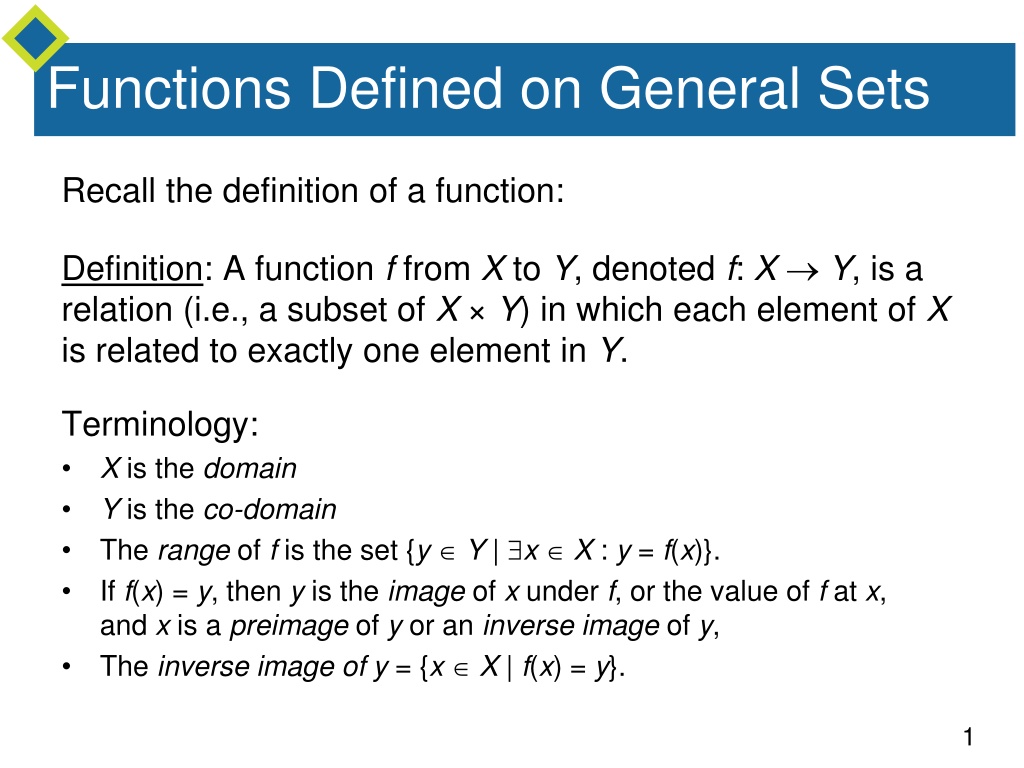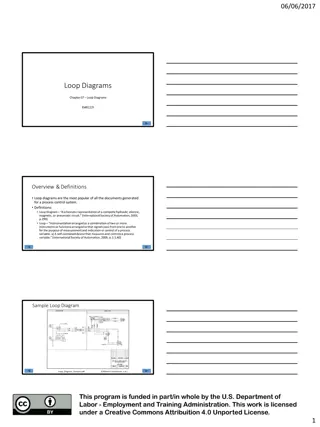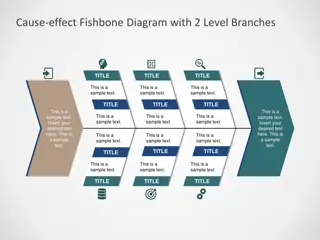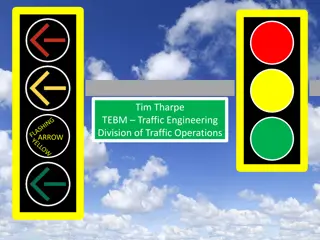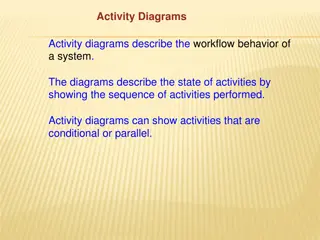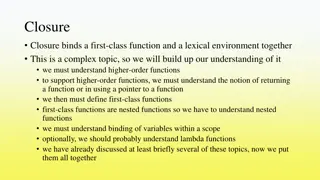Understanding Functions: Definitions and Arrow Diagrams
Recall the definition of a function, where each element in the domain is related to exactly one element in the co-domain. Arrow diagrams can visually represent functions from finite sets X to Y. In this example, a function is defined from X = {a, b, c} to Y = {1, 2, 3, 4} using arrow diagrams, showcasing domain, co-domain, values of f(a), f(b), f(c), range of f, and identifying inverse images.
Download Presentation

Please find below an Image/Link to download the presentation.
The content on the website is provided AS IS for your information and personal use only. It may not be sold, licensed, or shared on other websites without obtaining consent from the author. Download presentation by click this link. If you encounter any issues during the download, it is possible that the publisher has removed the file from their server.
E N D
Presentation Transcript
Functions Defined on General Sets Recall the definition of a function: Definition: A function f from X to Y, denoted f: X Y, is a relation (i.e., a subset of X Y) in which each element of X is related to exactly one element in Y. Terminology: X is the domain Y is the co-domain The range of f is the set {y Y | x X : y = f(x)}. If f(x) = y, then y is the image of x under f, or the value of f at x, and x is a preimage of y or an inverse image of y, The inverse image of y = {x X | f(x) = y}. 1
Arrow Diagrams If X and Y are finite sets, you can define a function f from X to Y by drawing an arrow diagram. You make a list of elements in X and a list of elements in Y, and draw an arrow from each element in X to the corresponding element in Y. 2
Arrow Diagrams This arrow diagram does define a function because 1. Every element of X has an arrow coming out of it. 2. No element of X has two arrows coming out of it that point to two different elements of Y. 3
Example 2 A Function Defined by an Arrow Diagram Let X = {a, b, c} and Y = {1, 2, 3, 4}. Define a function f from X to Y by the arrow diagram below. a. Write the domain and co-domain of f. Domain is {a, b, c}. Co-domain is {1, 2, 3, 4}. 4
Example 2 A Function Defined by an Arrow Diagram Let X = {a, b, c} and Y = {1, 2, 3, 4}. Define a function f from X to Y by the arrow diagram below. b. Find f(a), f(b), and f(c). f(a) = 2 f(b) = 4 f(c) = 2 5
Example 2 A Function Defined by an Arrow Diagram Let X = {a, b, c} and Y = {1, 2, 3, 4}. Define a function f from X to Y by the arrow diagram below. c. What is the range of f? Range is {2, 4}. 6
Example 2 A Function Defined by an Arrow Diagram Let X = {a, b, c} and Y = {1, 2, 3, 4}. Define a function f from X to Y by the arrow diagram below. d. Is c an inverse image of 2? Is b an inverse image of 3? Yes, c is an inverse image of 2. No, b is not an inverse image of 3. 7
Example 2 A Function Defined by an Arrow Diagram Let X = {a, b, c} and Y = {1, 2, 3, 4}. Define a function f from X to Y by the arrow diagram below. e. Find the inverse images of 2, 4, and 1. Inverse image of 2 is {a, c}. Inverse image of 4 is {b}. Inverse image of 1 is . 8
Example 2 A Function Defined by an Arrow Diagram Let X = {a, b, c} and Y = {1, 2, 3, 4}. Define a function f from X to Y by the arrow diagram below. f. Represent f as a set of ordered pairs. f = { (a, 2), (b, 4), (c, 2) } 9
Example 3 Equality of Functions Let J3= {0, 1, 2}, and define functions f and g from J3to J3 as follows: For all x in J3, Does f = g? Yes, the table of values shows that f(x) = g(x) for all x in J3. 10
Example 3 Equality of Functions Let F: R R and G: R R be functions. Define new functions F + G: R R and G + F: R R as follows: For all x R, Does F + G = G + F? Again the answer is yes. For all real numbers x, Hence F + G = G + F. 11
Examples of Functions: The Identity Function Given a set X, define a function IXfrom X to X by for all x in X. The function IXis called the identity function on X because it sends each element of X to the element that is identical to it. 12
Examples of Functions: Logarithms Examples: log3 9 = 2 since 32 = 9 log2 = 1 since 2 1 = log10 1 = 0 since 100 = 1 2log2m = m 13
Examples of Functions If S is a nonempty, finite set of characters, then a string over Sis a finite sequence of elements of S. The number of characters in a string is called the length of the string. Sl denotes the set of all strings over S of length l. The null string over Sis the string with no characters. It is usually denoted and is said to havelength0. 14
Example 9 Encoding and Decoding Functions Digital messages consist of finite sequences of 0 s and 1 s. When they are communicated across a transmission channel, they are frequently coded in special ways to reduce the possibility that they will be garbled by interfering noise in the transmission lines. For example, suppose a message consists of a sequence of 0 s and 1 s. A simple way to encode the message is to write each bit three times. Thus the message would be encoded as 15
Example 9 Encoding and Decoding Functions cont d The encoding function El is the function from {0,1} l to {0,1}3l defined as follows: For each string s {0,1}l, El(s)= the string obtained from s by replacing each bit of s by the same bit written three times. The decoding function Dlis defined as follows: For each string t {0,1}3l, Dl (t)= the string obtained from t by replacing each consecutive triple of three bits of t by their majority bit. 16
Example 9 Encoding and Decoding Functions cont d The advantage of this particular coding scheme is that it makes it possible to do a certain amount of error correction when interference in the transmission channels has introduced occasional errors into the stream of bits. 17
Example 11 A Boolean Function Consider the three-place Boolean function defined from the set of all 3-tuples of 0 s and 1 s to {0, 1}as follows: For each triple (x1, x2, x3) of 0 s and 1 s, Describe f using an input/output table. Solution: 19
Example 11 Solution cont d The rest of the values of f can be calculated similarly to obtain the following table. 20
Checking Whether a Function Is Well Defined It can sometimes happen that what appears to be a function defined by a rule is not really a function at all. To give an example, suppose we wrote, Define a function f :R R by specifying that for all real numbers x, This does not define a function, since for almost all values of x, either there is no y that satisfies the given equation or there are two different values of y that satisfy the equation. 21
Checking Whether a Function Is Well Defined For instance, when x = 2, there is no real number y such that 22 + y2 = 1, and when x = 0, both y = 1 and y = 1 satisfy the equation 02 + y2 = 1. In general, we say that a function is not well defined if it fails to satisfy the requirements for being a function. 22
Example 12 A Function That Is Not Well Defined We know thatQrepresents the set of all rational numbers. Suppose you read that a function f :Q Zis to be defined by the formula for all integers m and n with n 0. That is, the integer associated by f to the number is m. Is f well defined? Why? 23
Example 12 Solution The function f is not well defined. The reason is that fractions have more than one representation as quotients of integers. For instance, Now if f were a function, then the definition of a function would imply that since 24
Example 12 Solution cont d But applying the formula for f, you find that and so This contradiction shows that f is not well defined and, therefore, is not a function. 25
Checking Whether a Function Is Well Defined Note that the phrase well-defined function is actually redundant; for a function to be well defined really means that it is worthy of being called a function. 26
Functions Acting on Sets Given a function from a set X to a set Y, you can consider the set of images in Y of all the elements in a subset of X and the set of inverse images in X of all the elements in a subset of Y. 27
Example 13 The Action of a Function on Subsets of a Set Let X = {1, 2, 3, 4} and Y = {a, b, c, d, e}, and define F : X Y by the following arrow diagram: Let A = {1, 4}, C = {a, b}, and D = {c, e}. Find F(A), F(X), F 1(C), and F 1(D). 28
